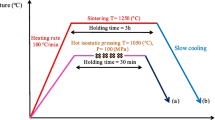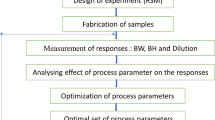Abstract
This study investigates the influence of cold wire drawing practices namely full die drawing (FDD) and half die drawing (HDD) on the deformation homogeneity in Co-35Ni-20Cr-10Mo alloy (MP35N) wires which are used for manufacturing implantable medical products. The inhomogeneous factor was used to assess the level of inhomogeneity in the wires, and electrical conductivity was measured on the wires, after drawn to different cold work (CW) reductions and with different drawing practices. Electron beam scattered diffraction, field emission scanning electron microscope and transmission electron microscope characterization were performed on the wire samples to correlate the mechanical and electrical properties to their texture and grain size. The results of this study conclude that the wires drawn with the FDD practice exhibited homogenous deformation, uniform microstructural and hardness gradient across the wire when compared to HDD wires. The electrical conductivity of the HDD-drawn wires was higher than the FDD wires and the level of inhomogeneity and the variation of conductivity decreased with the increase in CW.
















Similar content being viewed by others
References
G. Smith, Cobalt-Nickel Base Alloys Containing Chromium and Molybdenum, Google Patents, 1967
M. Fitzka, D. Catoor, D. Irrasch, M. Reiterer, and H. Mayer, Ultrasonic Fatigue Testing of Thin MP35N Alloy Wire, Proc. Struct. Integr., 2016, 2(Supplement C), p 1039–1046
M. Fitzka, D. Catoor, D. Irrasch, M. Reiterer, and H. Mayer, Fatigue Testing of Thin CoNiCr Wire up to 1010 Cycles, Int. J. Fatigue, 2017, 98(Supplement C), p 92–100
J.E. Schaffer, An Examination of Total Fatigue Life and Life Variability in Fine Medical Grade Wire, Medical Device Materials IV: Proceedings of the Materials & Processes for Medical Devices Conference, September 23-27, 2007, ASM International, Palm Desert, CA, 2008, p. 73
G.E. Dieter, H.A. Kuhn, and S.L. Semiatin, Handbook of Workability and Process Design, ASM International, Materials Park, 2003
A. Haddi, A. Imad, and G. Vega, Analysis of Temperature and Speed Effects on the Drawing Stress for Improving the Wire Drawing Process, Mater. Des., 2011, 32(8), p 4310–4315
A. Haddi, A. Imad, and G. Vega, The Influence of the Drawing Parameters and Temperature Rise on the Prediction of Chevron Crack Formation in Wire Drawing, Int. J. Fract., 2012, 176(2), p 171–180
G. Vega, A. Haddi, and A. Imad, Investigation of Process Parameters Effect on the Copper-Wire Drawing, Mater. Des., 2009, 30(8), p 3308–3312
C.J. Luis, J. León, and R. Luri, Comparison Between Finite Element Method and Analytical Methods for Studying Wire Drawing Processes, J. Mater. Process. Technol., 2005, 164–165(Supplement C), p 1218–1225
T.B. Coser, TFd Souza, and AdS Rocha, Avaliação numérica da influência da geometria do ferramental na geração de tensões residuais durante o processo de trefilação de barras de aço, Matéria (Rio de Janeiro), 2015, 20, p 819–831
H. Överstam, The Influence of Bearing Geometry on the Residual Stress State in Cold Drawn Wire, Analysed by the FEM, J. Mater. Process. Technol., 2006, 171(3), p 446–450
H.-S. Lin, Y.-C. Hsu, and C.-C. Keh, Inhomogeneous Deformation and Residual Stress in Skin-Pass Axisymmetric Drawing, J. Mater. Process. Technol., 2008, 201(1), p 128–132
A.K. Hassan and A.S. Hashim, Three Dimensional Finite Element Analysis of Wire Drawing Process, Univers. J. Mech. Eng., 2015, 3(3), p 71–82
L.K. Kabayama, S.P. Taguchi, and G.A.S. Martínez, The Influence of die Geometry on Stress Distribution by Experimental and FEM Simulation on Electrolytic Copper Wiredrawing, Mater. Res., 2009, 12, p 281–285
J. Luksza, J. Majta, M. Burdek, and M. Ruminski, Modelling and Measurements of Mechanical Behaviour in Multi-pass Drawing Process, J. Mater. Process. Technol., 1998, 80–81(Supplement C), p 398–405
M. Schaldach, Materials in Pacemaker Technology, Electrotherapy of the Heart, Springer, Berlin, 1992, p 169–190
C.S. Çetinarslan, Effect of Cold Plastic Deformation on Electrical Conductivity of Various Materials, Mater. Des., 2009, 30(3), p 671–673
D.-P. Lu, J. Wang, W.-J. Zeng, Y. Liu, L. Lu, and B.-D. Sun, Study on High-Strength and High-Conductivity Cu-Fe-P Alloys, Mater. Sci. Eng. A, 2006, 421(1–2), p 254–259
S. Nestorovic, D. Markovic, and L. Ivanic, Influence of Degree of Deformation in Rolling on Anneal Hardening Effect of a Cast Copper Alloy, Bull. Mater. Sci., 2003, 26(6), p 601–604
S. Nagarjuna, K. Balasubramanian, and D. Sarma, Effect of Prior Cold Work on Mechanical Properties, Electrical Conductivity and Microstructure of Aged Cu-Ti Alloys, J. Mater. Sci., 1999, 34(12), p 2929–2942
K. Maki, Y. Ito, H. Matsunaga, and H. Mori, Solid-Solution Copper Alloys with High Strength and High Electrical Conductivity, Scr. Mater., 2013, 68(10), p 777–780
P.L. Rossiter, The Electrical Resistivity of Metals and Alloys, Cambridge University Press, Cambridge, 1991
Standard Test Method for Microindentation Hardness of Materials, ASTM International, 2016
N. Brodusch, S. Boisvert, and R. Gauvin, Flat Ion Milling: A Powerful Tool for Preparation of Cross-Sections of Lead-Silver Alloys, Microscopy, 2013, 62(3), p 411–418
L. Koll, P. Tsipouridis, and E. Werner, Preparation of Metallic Samples for Electron Backscatter Diffraction and Its Influence on Measured Misorientation, J. Microsc., 2011, 243(2), p 206–219
Y.-J. Chen, J. Hjelen, and H.J. Roven, Application of EBSD Technique to Ultrafine Grained and Nanostructured Materials Processed by Severe Plastic Deformation: Sample Preparation, Parameters Optimization and Analysis, Trans. Nonferrous Met. Soc. China, 2012, 22(8), p 1801–1809
G.H. Hasani, R. Mahmudi, and A. Karimi-Taheri, On the Strain Inhomogeneity in Drawn Copper Wires, Int. J. Mater. Form., 2010, 3(1), p 59–64
J. Petruška and L. Janıček, On the Evaluation of Strain Inhomogeneity by Hardness Measurement of Formed Products, J. Mater. Process. Technol., 2003, 143–144(Supplement C), p 300–305
M.P. Riendeau, M.C. Mataya, and D.K. Matlock, Controlled Drawing to Produce Desirable Hardness and Microstructural Gradients in Alloy 302 Wire, Metall. Mater. Trans. A, 1997, 28(2), p 363–375
L. Sadok, J. Luksza, and J. Majta, Inhomogeneity of Mechanical Properties in Stainless Steel Rods After Drawing, J. Mater. Process. Technol., 1994, 44(1), p 129–141
S. Suwas and R.K. Ray, Crystallographic Texture of Materials, Springer, London, 2014
U.F. Kocks, H.-R. Wenk, and C.N. Tomé, Texture and Anisotropy: Preferred Orientations in Polycrystals and Their Effect on Materials Properties, Cambridge University Press, Cambridge, 1998
G.E. Dieter and D.J. Bacon, Mechanical Metallurgy, McGraw-Hill, New York, 1988
D.J. Dunstan and A.J. Bushby, Grain Size Dependence of the Strength of Metals: The Hall–Petch Effect does not Scale as the Inverse Square Root of Grain Size, Int. J. Plast., 2014, 53(Supplement C), p 56–65
O. Engler and V. Randle, Introduction to Texture Analysis: Macrotexture, Microtexture, and Orientation Mapping, 2nd ed., CRC Press, Boca Raton, 2010
S. Asgari, Anomalous Plastic Behavior of Fine-Grained MP35N Alloy During Room Temperature Tensile Testing, J. Mater. Process. Technol., 2004, 155–156(Supplement C), p 1905–1911
S. Asgari, E. El-Danaf, S.R. Kalidindi, and R.D. Doherty, Strain Hardening Regimes and Microstructural Evolution During Large Strain Compression of Low Stacking Fault Energy fcc Alloys that Form Deformation Twins, Metall. Mater. Trans. A, 1997, 28(9), p 1781–1795
E. El-Danaf, S.R. Kalidindi, and R.D. Doherty, Influence of Grain Size and Stacking-Fault Energy on Deformation Twinning in fcc Metals, Metall. Mater. Trans. A, 1999, 30(5), p 1223–1233
S.R. Kalidindi, Modeling the Strain Hardening Response of Low SFE FCC Alloys, Int. J. Plast., 1998, 14(12), p 1265–1277
S.S. Gvk, M.J. Tan, and Z. Liu, Influence of Drawing Practices on the Mechanical, Texture and Work Hardening Characteristics of Co-Cr-Ni-Mo Wires, Mater. Sci. Eng. A, 2018, 713, p 94–104
C. Pande and K. Cooper, Nanomechanics of Hall–Petch Relationship in Nanocrystalline Materials, Prog. Mater Sci., 2009, 54(6), p 689–706
J. Schiøtz, F.D. Di Tolla, and K.W. Jacobsen, Softening of Nanocrystalline Metals at Very Small Grain Sizes, Nature, 1998, 391(6667), p 561
H.G. Mond and J. Helland, Engineering and Clinical Aspects of Pacing Leads, Clinical Cardiac Pacing and Defibrillation, WB Saunders Co, Philadelphia, 2000, p 127–150
A. Matthiessen and C. Vogt, IV. On the Influence of Temperature on the Electric Conducting-Power of Alloys, Philos. Trans. R. Soc. Lond., 1864, 154, p 167–200
S.I. Hong and M.A. Hill, Mechanical Stability and Electrical Conductivity of Cu-Ag Filamentary Microcomposites, Mater. Sci. Eng. A, 1999, 264(1–2), p 151–158
A. Mayadas and M. Shatzkes, Electrical-Resistivity Model for Polycrystalline Films: The Case of Arbitrary Reflection at External Surfaces, Phys. Rev. B, 1970, 1(4), p 1382
R. Brown, A Dislocation Model of Grain Boundary Electrical Resistivity, J. Phys. F Met. Phys., 1977, 7(8), p 1477
S. Kasap, Springer Handbook of Electronic and Photonic Materials, Springer, Berlin, 2006
Y.F. Zhu, X.Y. Lang, W.T. Zheng, and Q. Jiang, Electron Scattering and Electrical Conductance in Polycrystalline Metallic Films and Wires: Impact of Grain Boundary Scattering Related to Melting Point, ACS Nano, 2010, 4(7), p 3781–3788
W.A. Backofen, Deformation Processing, Addison-Wesley, Reading, 1972
A. Nakagiri, T. Yamano, M. Konaka, K. Yoshida, M. Asakawa, Chevron Crack and Optimum Drawing Condition in the Diagram of Mean Stress and Die-Wire Contact Length Ratio by FEM Simulation. Wire & Cable Technical Symposium, 2000, p 75–82
R.N. Wright, Wire Technology: Process Engineering and Metallurgy, Elsevier, Amsterdam, 2011
B. Avitzur, Metal Forming: Processes and Analysis, R. E. Krieger Pub. Co., Huntington, 1979
W. Oliferuk, M. Maj, K. Zembrzycki, Distribution of Energy Storage Rate in Area of Strain Localization During Tension of Austenitic Steel, IOP Conference Series: Materials Science and Engineering, IOP Publishing, 2015, p 012055
A. Iziumova, A. Vshivkov, A. Prokhorov, A. Kostina, and O. Plekhov, The Study of Energy Balance in Metals Under Deformation and Failure Process, Quant. Infrared. Thermogr. J., 2016, 13(2), p 242–256
Acknowledgments
This work was supported financially by EDB (Economic Development Board), Singapore (COY-15-IPP-140010/198501914Z) under the EDB-IPP scheme through a grant to Heraeus Materials Singapore Pte Ltd Singapore.
Author information
Authors and Affiliations
Corresponding author
Rights and permissions
About this article
Cite this article
Gvk, S.S., Tan, M.J. & Liu, Z. Study on the Deformation Homogeneity and Electrical Conductivity in Co-Cr-Ni-Mo Wires Drawn with Different Drawing Practices. J. of Materi Eng and Perform 28, 330–342 (2019). https://doi.org/10.1007/s11665-018-3755-2
Received:
Revised:
Published:
Issue Date:
DOI: https://doi.org/10.1007/s11665-018-3755-2




